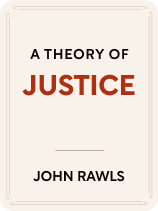

This article is an excerpt from the Shortform book guide to "A Theory of Justice" by John Rawls. Shortform has the world's best summaries and analyses of books you should be reading.
Like this article? Sign up for a free trial here.
What’s a definition of justice everyone can agree on? How should wealth and power be distributed in society? What obligations do citizens have to each other?
These are some of the questions John Rawls confronts in his 1971 work, A Theory of Justice. The conclusion is Rawls’s theory of “justice as fairness,” which merges liberalism’s emphasis on equal rights and individualism with economic equality and safety nets for the most vulnerable members of society.
Below is a brief overview of John Rawls’s book A Theory of Justice.
A Theory of Justice by John Rawls
In A Theory of Justice, 20th-century American political philosopher John Rawls explores the best and most just way a society can distribute social goods like rights, opportunities, wealth, and power. He argues that people can and should determine the distribution of these goods entirely through reason and logic, rather than by appeals to one’s identity—sex, race, religion, and so on. This idea is the underpinning of Rawls’s theory of “justice as fairness,” which allows for basic human rights, some degree of social and economic equality, and a safety net for more vulnerable members of society. Released in 1971, John Rawls’s book A Theory of Justice is a popular and influential modern defense of liberalism that continues to be cited, discussed, and debated by philosophers and politicians alike.
We’ll explore Rawls’s theory of justice as fairness in four parts:
- Part 1: What Justice Is and Is Not explains the question Rawls tries to answer as well as his critiques of other theories of justice.
- Part 2: The Theory of Justice as Fairness goes through the main principles of Rawls’s theory and how he arrives at them.
- Part 3: Justice as Fairness in Society expands on how Rawls’s theory creates a just society.
- Part 4: Living Under Justice as Fairness describes the obligations citizens have to society under justice as fairness.
Part 1: What Justice Is and Is Not
Before we discuss the specific principles of Rawls’s theory of justice, we first have to understand how he defines justice—as well as his critique of the other dominant theory of justice at the time: utilitarianism. By outlining what Rawls means when he refers to “justice” or “a just society,” we can fully understand the scope of Rawls’s theory and how his philosophy applies to real political circumstances.
In Part 1 of our guide, we’ll explain the following:
- Rawls’s definition of justice
- Rawls’s critique of utilitarianism
Rawls’s Definition of Justice
Rawls defines justice as the dominant ideology or goal underlying the rules of society—in other words, why people create and follow a society’s rules. Under this definition, justice is a generally held idea of the best and most moral way of organizing society. Rawls says there’s no universal sense of justice that all societies agree on; different societies have different theories of what’s just and unjust. Members of each society try to make specific political and economic rules that are just—according to their own theory of justice.
These rules then determine how that society distributes “primary benefits”: things that help people achieve their goals in life no matter what they might be. Rawls says the main primary benefits are rights, liberties, opportunities, wealth or income, and a sense of self-worth (not being treated as inferior by society).
Here’s an example of how a principle of justice informs a rule, which in turn informs the distribution of a primary benefit:
Rawls’s Critique of Utilitarianism
After defining justice, Rawls then focuses on theories of justice—in other words, the specific ideologies and goals that people believe are best for society. Before outlining his own theory of justice, Rawls critiques what he characterizes as the dominant theory of justice at the time: utilitarianism.
A utilitarian theory of justice believes society should aim to provide the most social benefits or “utility” possible to the most people possible. Utilitarians quantify social benefits (rights, wealth, liberties, and so on) in terms of the pain or pleasure they provide. They then argue that society’s rules for distribution should maximize pleasure and minimize pain for the largest number of people possible. For example, a utilitarian argument for speed-limit laws suggests the social benefits they give people (greater safety for all drivers, minimizing the pain of potential car accidents) outweigh the social benefits they take away from people (the pleasure certain individuals gain from being free to drive as fast as they want) and are therefore just.
Rawls argues that utilitarian theories of justice are flawed because they allow for a majority of people to oppress a minority—when social benefits, such as greater wealth or opportunities, provided to the majority outweigh the social benefits that the minority are deprived of, such as liberty, rights, and wealth. For example, if a utilitarian could prove that chattel slavery pleasured the enslavers more than it harmed the enslaved, then they would say that institution was just.
Rawls believes this kind of oppression is inherently immoral and that utilitarianism fails to acknowledge this. Even utilitarian theories that allow for equal rights and liberties only do so because they believe that equal rights create the most benefits possible—and not because they believe people have an inherent right to avoid oppression or that oppression is inherently wrong.
Part 2: The Theory of Justice as Fairness
After explaining what justice is and critiquing utilitarian theories of justice, Rawls then considers how to create an ideal theory of justice. “Ideal” in this case doesn’t refer to rules that can create a perfect government or utopian society. Instead, Rawls says an ideal theory of justice is one that a group of equals could rationally agree is best, regardless of their own personal backgrounds or circumstances.
The Original Position
To determine the ideal principles of justice, Rawls uses a thought experiment he calls “the original position”: a hypothetical situation where a group of equals must create a rational definition of justice. The members of this group act as representatives of real citizens in a society at a one-to-one ratio—each citizen has their own representative. The representatives are all equally clearheaded and competent, they all have an equal say, and they all have to agree on a definition of justice before it’s finalized. In addition, they must arrive at this definition entirely through rational debate—they can’t use any threats of violence, appeals to emotion, or attempts to persuade each other through rhetoric alone.
The Original Position Framework
Rawls outlines the three main circumstances that every representative is aware of in the original position:
1) In this hypothetical society, there’s a medium level of scarcity. This means that there are enough primary benefits to meet everyone’s basic needs, but there aren’t enough primary benefits for everyone to get everything they want.
2) Each representative wants to ensure that their citizen receives enough primary benefits to live a fulfilling life.
3) Whatever definition of justice the representatives come up with has to be fair to all citizens. This is because all representatives are rational and on equal footing—nobody will arbitrarily agree to a definition that gives their citizen fewer benefits than everyone else, and nobody can coerce a representative into accepting a definition that gives their citizen fewer benefits than everyone else.
The Veil of Ignorance
While the representatives understand the above circumstances, Rawls also explains that there are some things that they don’t know—a lack of knowledge that he calls the “veil of ignorance.” Under the veil of ignorance, the representatives don’t know the specific life circumstances of those they represent—things like race, sex, gender, age, wealth, natural talents, and religious beliefs. Because the representatives don’t know these circumstances, they’ll only argue for a definition of justice that benefits a general citizen, rather than a citizen with specific traits or qualities.
For example, a representative speaks on behalf of Jolene, a wealthy Buddhist woman.
- Without the veil of ignorance, the representative knows these things about Jolene and would argue for a definition of justice that benefits the wealthy, or for the Buddhist definition of justice.
- With the veil of ignorance, however, the representative simply knows they speak on behalf of “Citizen J.” Therefore, they won’t argue for a definition of justice that favors the wealthy or Buddhists—for all they know, Citizen J could be a poor Protestant, a middle-class Muslim, or anything else.
The Original Position Negotiation
Rawls then explains how a group of representatives might negotiate in the original position. He acknowledges that while not every group will follow the exact process he outlines here, they’d still arrive at many of the same conclusions. In addition, Rawls notes that in this process, groups of representatives wouldn’t tend toward utilitarian theories of justice—nobody would risk giving up their individual rights and freedoms to benefit others even if doing so led to the most utility collectively.
The process of negotiating in the original position consists of three steps:
Step #1: Complete Equality
As previously discussed, nobody will arbitrarily accept fewer primary benefits, nor will they accept others arbitrarily getting more primary benefits than they do. Therefore, the group will initially agree that everyone should get equal amounts of primary benefits. We’ll call this a state of “complete equality.”
Step #2: The Benefits of Inequality
However, according to Rawls, there are some instances where inequalities of wealth and power can actually leave everyone with more primary benefits than they’d have in a state of complete equality. These inequalities can improve efficiency and leave everyone with more than they would have had otherwise.
For example, a group is building a dam that will provide benefits to everyone—flood protection, water, hydroelectricity, and so on. In a state of complete equality, nobody has the authority to give orders or the resources to fully fund the project. But with some inequality of wealth and power, the group could have a leader to organize the project and a wealthy individual to provide the funding for it. In this case, some inequality would help the group build the dam much more efficiently (or at all) so everyone could benefit from it.
Therefore, in the original position, people can accept inequalities of wealth and power (but not of basic rights and liberties) as long as these inequalities benefit everyone and are administered fairly.
Step #3: Administering Inequality Fairly
To ensure that these inequalities are administered fairly, the group would attach them to positions or roles in society, then add the condition that everyone has an equal opportunity to fill these roles—this ensures that people with additional power and wealth are accountable to society as a whole and that those rules aren’t arbitrarily limited to some people over others.
According to Rawls, the group would also add the condition that unequal distributions of wealth or power should provide the greatest possible benefit to those with the least. Even when inequalities leave everyone better off than they were before, they’ll still inevitably leave some people with less wealth and power than everybody else. This second condition prevents distributions where those with the most benefit at the expense of those with the least. Representatives don’t know whether or not they’re advocating for someone with very little, so they’d want to ensure these benefits for the least fortunate just in case.
For example: In a state of complete equality, everyone has $25,000. The society decides to build the dam mentioned above and has to choose among three unequal distributions:
- Because of their salaries, dam managers now have $100,000 and dam workers now have $75,000. Because of cheaper water and power, everyone else now has $35,000.
- Society invests more in the dam to make it better. Dam managers now have $200,000 and dam workers now have $100,000. Water and power are even cheaper, so everyone else has $50,000.
- Society invests even more in the dam. Dam managers now have $250,000, dam workers now have $150,000, and everyone else has $30,000 due to high dam taxes.
While everyone is better off with the dam than they are without it, according to Rawls, the second scenario is the most just unequal distribution because it provides the greatest possible benefit to those with the least.
The Conclusion of The Original Position
The result of the negotiations above is the theory of justice Rawls calls “justice as fairness.”
Justice as fairness has two principles:
- All citizens have equal fundamental rights that nobody can take away.
- Citizens can have unequal amounts of wealth and power only under the following circumstances:
- These unequal distributions benefit everyone in society and most benefit those with the least amount of wealth and power.
- Everyone has an equal opportunity to obtain wealth and power.
Part 3: Justice as Fairness in Society
After discussing how he arrives at the two principles of justice as fairness, Rawls then goes into more detail on what these principles mean for society—discussing how each principle might influence the rules and distribution systems of society. Specifically, Rawls outlines the following:
- Principle #1: Everyone in society should have basic equal rights, liberties, and duties.
- Principle #2: Unequal distributions of wealth and power are just under certain circumstances.
Principle #1: Everyone Should Have Equal Rights, Liberties, and Duties
Rawls’s first principle states that everyone in society should have basic equal rights, liberties, and duties. As previously discussed, this principle derives naturally from the original position, since everyone involved would want to guarantee they weren’t oppressed. To further explore this first principle, we’ll examine Rawls’s definition of rights and liberties as well as how he says social institutions can resolve conflicts between different rights and liberties.
Defining Rights and Liberties
Rawls frames rights, liberties, and duties in terms of limits on actions: what people are (or are not) allowed or able to do. He doesn’t define every single right, liberty, and duty that he believes is just, suggesting instead that this is the job of social institutions. However, he does note several important examples: freedom of religion, freedom of speech, the right to equal political participation, and property rights. In addition, Rawls’s conception of political equality extends beyond detached formal rules to include the equal right to exercise political power (by holding office or voting in an election, for example). This right ensures that people who already have some degree of wealth and power don’t get a greater say in political decisions.
For example, a formal rule ensures that each citizen has one vote in an election. However, this doesn’t guarantee equality by itself—Prudence, who is wealthy, can spend far more money than the average citizen to organize people around her political platform and campaign for votes. In this situation, Prudence would, in practice, be able to exercise more political power than most. Therefore, Rawls believes the state must place limits on the role of wealth in political organization or provide resources to those with less so they too can organize around issues.
Rights, Liberties, and Conflicts
Sometimes, different rights and liberties will contradict each other, acknowledges Rawls—for example, if someone randomly threatens to kill a stranger on the street, the threatener’s right to free speech conflicts with the stranger’s right to personal safety. To address this conflict, Rawls says representatives in the original position would attach two additional rules to the first principle:
1) A society can restrict certain liberties but only if doing so creates greater liberty for everyone. For example, privacy laws restrict an individual’s liberty to spy on their neighbors, but these laws create a broader right to privacy for everyone in society. In addition, Rawls suggests that this rule makes it unjust for a majority in society to oppress a minority. While that may limit the right of the majority to freely exercise political power, it preserves many more crucial rights and freedoms of the minority.
Rawls acknowledges that in a real society, social and historical circumstances interfere with perfect equality—for example, a historically oppressed group might still struggle to obtain true equality even in a society that believes everyone should have equal rights. Or, a violent political faction might have fewer rights to express their views for the sake of public order. In these cases, Rawls suggests it’s the duty of society to continuously work toward the greatest overall liberty—addressing the largest injustices first and making decisions based on what makes everyone as equal and free as possible.
2) Some people can have less liberty than others if they consent to it. There are circumstances where people need others to act on their behalf. In this case, it’s just for an individual to entrust some of their liberty in a guardian—so long as the guardian rationally considers what the individual would want if they could act for themselves. For example, a coma patient needs (and presumably wants) someone to act on their behalf. Therefore, it’s just for someone they trust, like a doctor or family member, to temporarily act on their behalf, making decisions based on what they think the coma patient would want.
Principle #2: Some Inequality Is Just Under Certain Circumstances
Rawls’s second principle argues that inequalities of wealth and political power are just under certain circumstances. We discussed two of these circumstances in Part 2:
- Unequal distributions of wealth and power must benefit everyone and must provide the greatest possible benefit to those with the least wealth and power.
- These inequalities come from jobs in society that everyone has equal opportunities to fill. They include public positions, like government bureaucrats, as well as private positions—everything from CEOs to dentists.
Rawls adds three rules to clarify his second principle:
Rule #1: Rights Have Priority Over Inequality
According to rule #1, unequal distributions of power and wealth aren’t just if they infringe upon people’s basic rights and freedoms. Rawls says that if there’s ever a time when universal rights and unequal wealth or power conflict, then society must prioritize rights. For example, an excellent leader has provided society with incredible benefits—so much so that many people want to make their leader an absolute dictator for life. While this increased inequality of power might provide society with the benefits of a skilled leader, it’s unjust because it would deprive everyone of their basic right to exercise political power.
Rule #2: Account for Talent and Class
Rule #2 states that to ensure equal opportunity, the state must account for differences in natural talent and social class. Rawls argues that society shouldn’t limit opportunities necessary for obtaining wealth and power (education, jobs, and so on) to those who already have wealth or to those who are naturally talented. The class a person is born into and their natural talents are determined by chance, and therefore shouldn’t decide moral questions of who gets what in society.
To account for differences in class, Rawls says the state must make education accessible to everyone—both in a technical or academic sense (medical school, for example) as well as in a cultural and experiential sense (an opportunity to network with practicing doctors, for example). To account for differences in natural talent, Rawls believes the difference principle must also apply to skilled versus unskilled labor—skilled laborers shouldn’t earn more than unskilled laborers, unless that would provide a greater benefit to those in the latter category.
Rule #3: Some Unequal Opportunity Is Just
Rule #3 states that unequal opportunity is just as long as it benefits those with fewer opportunities more than it burdens everyone else. Society can provide additional opportunities to the less fortunate who otherwise struggle to gain wealth and power. This is just so long as the benefit to the unfortunate outweighs the burden on the fortunate. For example, New Zealand’s parliament reserves specific seats for Māori citizens—a historically oppressed group indigenous to the island. Rawls might argue that this unequal opportunity is just since it benefits an underrepresented group (the Māori) more than it harms an overrepresented group (non-indigenous New Zealanders).
Part 4: Living Under Justice as Fairness
After outlining the full principles of justice as fairness, Rawls discusses citizenship under justice as fairness. Rawls argues a just society should allow people to live however they like. It shouldn’t define an “ideal” way to live or moral code—justice as fairness purposely avoids doing so by relying entirely on the rational and logical debate in the original position. Rawls’s view on life in society is clear from his definition of primary benefits that we discussed in Part 1: benefits that allow someone to live whatever kind of life they want.
However, there are some exceptions to Rawls’s rule of everyone living however they like—areas where he believes society should enforce certain duties and values. Let’s explore each of these exceptions in more detail:
Exception #1: Duties to Society
While Rawls argues that societies must have duties that fit their specific circumstances, he does emphasize three in particular. Rawls believes that these duties promote the common good while still allowing citizens to pursue their own self-interest. Let’s explore each and examine how they accomplish this goal:
Duty #1: Follow Existing Just Rules
The first duty is to follow existing rules and laws in society that are just. This duty ensures citizens will follow the main principles of justice as fairness, which Rawls believes work toward the common good.
In addition, this duty helps preserve social stability—something else that Rawls believes is a common good. It does so by ensuring citizens use existing political methods (voting, for example) to accomplish their goals instead of more radical, destabilizing methods that go against existing laws (violent protests or civil disobedience, for example). Rawls argues that citizens should only use these more drastic measures to address major injustices or violations of the principles of justice as fairness.
Duty #2: Create Just Rules
The second duty citizens have is to help create just rules if they don’t exist—as long as doing so isn’t at a great personal cost. This duty ensures citizens will continue working to make their society more just, another common good. In addition, it allows citizens to pursue the common good in a way that doesn’t interfere with their own personal interests, since they won’t have to give up too much in their pursuit of a just society.
For example, while citizens might have a duty to advocate or vote for a just public housing policy, Rawls doesn’t believe they’re obligated to allow homeless people to move in with them.
Duty #3: Mutually Respect Fellow Citizens
Rawls’s third duty requires citizens to be polite and respect one another. This means making a genuine attempt to understand others as well as having a certain degree of honesty, integrity, and generosity. This duty provides everyone a common good—living in a society full of considerate and helpful people—without harming the personal goals and interests of citizens much.
Exception #2: Preferable Life
While Rawls doesn’t want to define an ideal way for someone to live their life, he does provide a broad sense of what kind of life might be preferable. Specifically, he argues in favor of a “rational life”: overall goals and values in life consistent with what someone would rationally choose. Unlike a specific idea of the best way to live, Rawls believes that the value of a rational life is self-evident instead of appealing to a broader sense of morality—after all, rational life is in service of what you yourself would choose in a moment of rational deliberation.
Exception #3: Shared Conceptions of Value
While Rawls believes in avoiding judgments on how people live their lives, he does acknowledge that some society-wide conception of excellence is important—shared ideas of what is and isn’t valuable help people cooperate and communicate. For example, if you want someone to build you a barn, then you’d want to have a shared idea of what makes an excellent barn. Rawls introduces a relatively bare-bones definition of excellence that he believes works within justice as fairness: A thing (for example, an object, idea, or activity) is excellent if a rational person determines that it’s better than others of its type for living a fulfilling life. Let’s break down this definition into three parts, using an example:
- Randolph is trying to live a fulfilling life guided by reason. He wants to buy a new bike. He notices the Speedy Bike 100.
- Randolph uses rational deduction (examining the bike, testing it out, and so on) to determine that the Speedy Bike 100 is faster, safer, and easier to handle than most other bikes. These are all qualities he wants in a bike and qualities that will help him live his life—it’ll keep him safe and get him where he needs to go quickly.
- Therefore, the Speedy Bike 100 is an excellent bike—a rational person (Randolph) determines that it’s better than other bikes at helping him live a fulfilling life.
Rawls’s theory of a shared conception of value doesn’t just allow people to compare different objects—people can use the same process to evaluate how “good” a decision is based on all the options available and on the potential consequences of it.

———End of Preview———
Like what you just read? Read the rest of the world's best book summary and analysis of John Rawls's "A Theory of Justice" at Shortform.
Here's what you'll find in our full A Theory of Justice summary:
- John Rawls's 1971 theory of justice as fairness
- A breakdown of Rawls's Original Position theory and framework
- The three duties every citizen has in a just society






